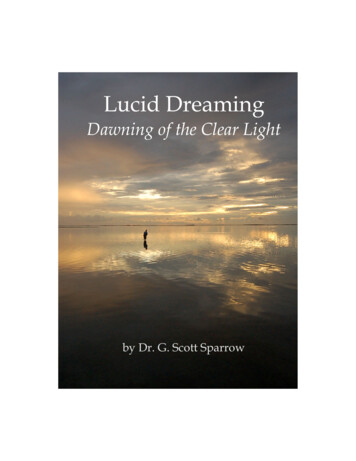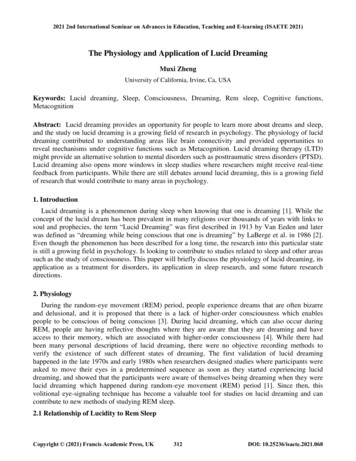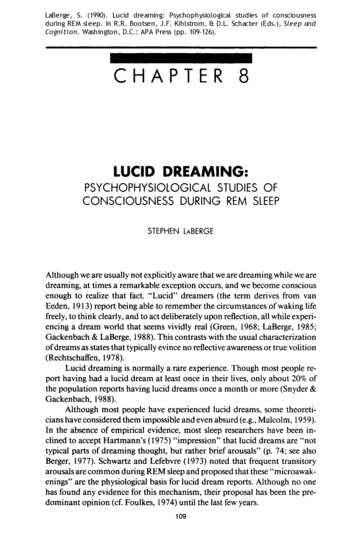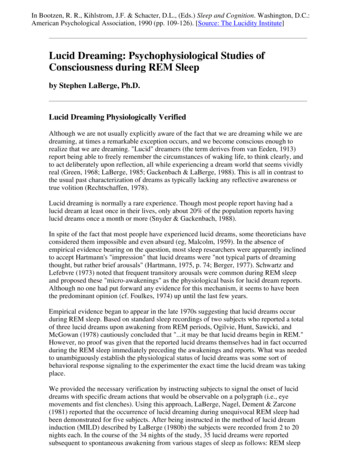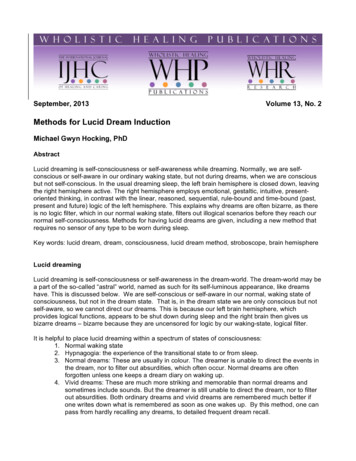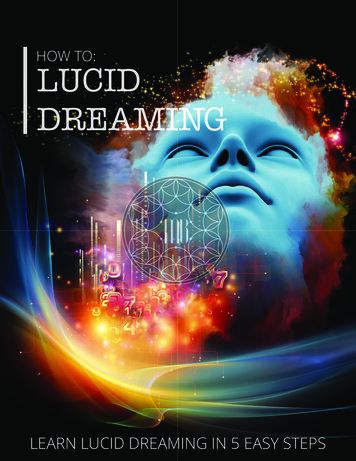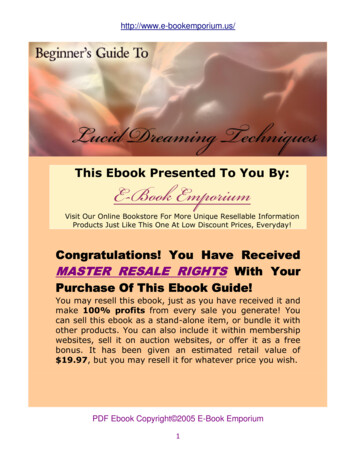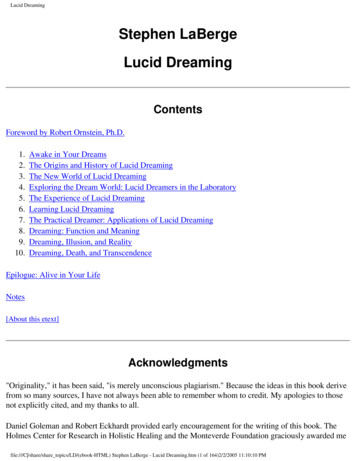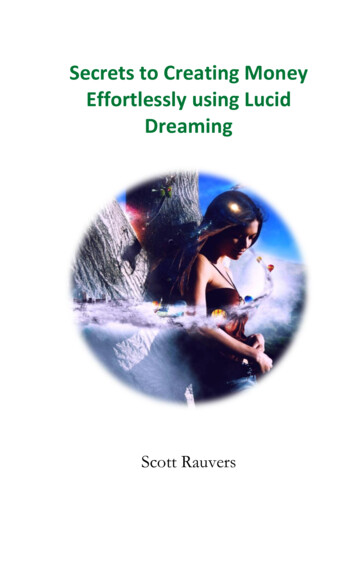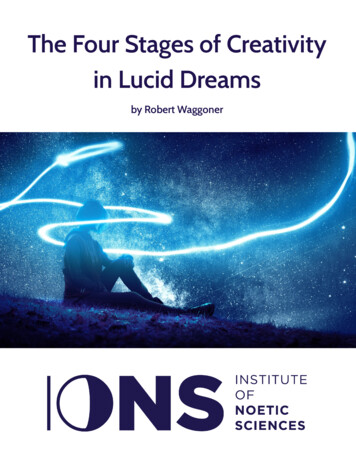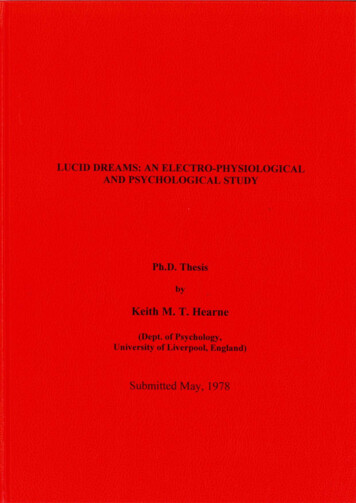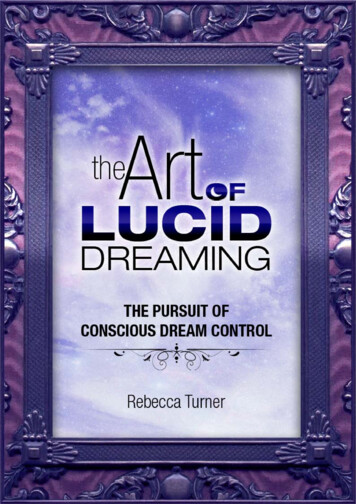
Transcription
The Art of Lucid Dreaming: The Pursuit of Conscious Dream Control1
Published by Creative Media NZ LtdCover Design and Book Design by Peter Casalewww.cre8ve.co.nzCopyright 2009 Creative Media NZ LtdWritten and Edited by Rebecca TurnerArtwork courtesy of Jeremiah Morelliwww.Morjers-Art.deCopyright 2011 Jeremiah MorelliAll rights reserved. No part of this publication may be reproduced or utilized in any form or by anymeans, electronic or mechanical, including photocopying, recording, or by any information storage andretrieval system, without prior written permission of the publisher.DisclaimerThe advice in this book is provided as general information only. The publisher cannot guarantee that thisinformation is free of typographical or content errors. Furthermore, each piece of content contains educational information only up to its original publication date. The supplements described in this book areintended for adults only. Persons under the age of 18 should not take any supplements for any reasonwithout first consulting with a qualified physician. The publisher nor the author shall be held responsible for any negative effects on health or wellbeing as a result of using the techniques or supplementsdescribed.THE AUTHOR AND THE PUBLISHER WILL ASSUME NO LIABILITY NOR RESPONSIBILITY TO ANY PERSONOR ENTITY WITH RESPECT TO ANY LOSS OR DAMAGE RELATED DIRECTLY OR INDIRECTLY TO THE INFORMATION IN THIS BOOK. THE PUBLISHER WILL PROVIDE NO REMEDY FOR INDIRECT, CONSEQUENTIAL,PUNITIVE, OR INCIDENTAL DAMAGES ARISING FROM THIS BOOK, INCLUDING SUCH FROM NEGLIGENCE,STRICT LIABILITY, OR BREACH OF WARRANTY OR CONTRACT, EVEN AFTER NOTICE OF THE POSSIBILITYOF SUCH DAMAGES.2The Art of Lucid Dreaming: The Pursuit of Conscious Dream Control
ContentsIntroduction . .5Part 3: Lucid Dreaming SupplementsAbout The Author . .8Calea Zacatechichi.65Galantamine & Choline.67Part 1: The Nature of Sleep and DreamsVitamin B.69A History of Sleep.12The Stages of Sleep.15Part 4: Lessons in Dream ControlWhy Do We Dream?.21Levels of Lucidity.71Dream Interpretation.26How To Stay Lucid in Dreams . .74The Hypnagogic State.31How to Control Your Dreams .779 Reasons to Lucid Dream.34Setting a Lucid Dream Intention.80Five Lucid Dream Challenges.83Part 2: Lucid Dreaming TechniquesLucid Dreaming Sex.87How to Remember Your Dreams .40False Awakenings.90Keeping a Dream Journal . .42Escaping From Nightmares .93Reality Checks . .44Sleep Paralysis.96Mnemonic Induction of Lucid Dreams.48Wake Induced Lucid Dreams.51Part 5: Advanced Lucid DreamingThe Cycle Adjustment Technique.5510 Things to Ask Your Lucid Dream.99Wake Back To Bed . .57Interview with Robert Waggoner.101Guided Meditation.58Final Thoughts.109Self Hypnosis.61The Art of Lucid Dreaming: The Pursuit of Conscious Dream Control3
IntroductionAll men whilst they are awakeare in one common world:but each of them,when he is asleep,is in a world of his own. PlutarchArtwork: Fernwehby Jeremiah Morelli4The Art of Lucid Dreaming: The Pursuit of Conscious Dream Control
IntroductionAlucid dream creates a mind-blowing alternate reality where you can fly over breathtaking scenery, teleport to the edge of the universe, interact with other dream figures, and communicatewith your subconscious inner self. The applications of lucid dreaming are limitless and I amgoing to help you explore that infinite potential. That is my promise.This introduction provides an overview of lucid dreaming as we know it. Bits of it may sound vaguelyfamiliar - but please don’t skip anything, even if you think you already understand the concept ofdream control. In truth, the lucid dreamscape is widely misunderstood, and I want to ensure you beginthis journey armed with the facts - and not the myths. This will help you become a proficient luciddreamer much faster, and is what makes this my definitive beginner’s guide to lucid dreaming.What is Lucid Dreaming?Lucid dreaming is the ability to consciously observe and/or control your dreams. Having consciousnesswithin the dreamstate transforms it into a living alternate reality - where everything you see, hear,feel, taste and even smell can be as authentic as real life.Indeed, the French philosopher Rene Descartes found his lucid dreams were so vivid, he concludedthat our waking senses are illusory and not to be trusted! The sheer realism of lucid dreams forces usto question the very nature of our waking reality.How is this possible? How can our brains create such a solid, lifelike environment from complete fantasy, that is so vivid it could be confused with real life?The answer is locked away in the secrets of the human brain - and one major clue is the fact thatlucidity can occur at a higher state of consciousness (in the GAMMA range) than regular dreaming,and even higher than your level of conscious alertness right now. This is what creates the distinctionbetween distant and fuzzy regular dreams - and vibrant and intense lucid dreams.So, the basic definition of a lucid dream is this: heightened awareness during dreams. The phrases ‘lucid dreams’, ‘conscious dreams’ and ‘guided dreams’ are used interchangeably throughout this book.They all mean the same thing.The Art of Lucid Dreaming: The Pursuit of Conscious Dream Control5
How Much Control Do You Really Have in a Lucid Dream?With mental focus, a conscious dream allows you to control your own actions as well as your environment and even other dream characters. In fact, if put to the test, there is probably no dream elementthat is out of bounds. However, this doesn’t mean you should aim to control everything in a luciddream - that would be preposterous when you think about it.With self-awareness in the dream world, the capacity for dream control is merely a novelty bonus. Itbecomes possible for two reasons:1. The dream world is an imaginary creation - it is sheer fantasy, an illusory reality -- so there areno physical laws to stop anything you want from happening.2. When conscious, the dreamer possesses the clarity of thought to guide their self-awarenessthrough the dreamscape at will.Many beginners assume that lucid dreaming must equal full dream control but this is a major misconception. Lucid dreaming only means to have consciousness within the dream state. This can implydream control, or it can imply simply observing the dream world with the clarity of thought enabled byyour heightened awareness. Both are very appealing propositions.However, some expert lucid dreamers despise the fact that it is popularized as dream control. As if lucidity is a mere psychological novelty trick that allows you to fly, have sex, take part in extreme sportsand all the other instantly gratifying activities that beginners tend to go for. Advanced dream explorerscontend that conscious dreaming is a profound and enlightening state of awareness, and to play it likea video game is a disservice to the grand spiritual nature of this transcendental state.As the leading lucid dream researcher Robert Waggoner put it, “The sailor does not control the sea”- that is, your consciousness is the ship that navigates through a subconscious ocean. If you truly hadto control everything and populate every dream scene with every leaf and blade of grass and wisp ofcloud, you would have your hands full just creating and maintaining decent scenery!So it’s crucial to acknowledge that the subconscious mind is a co-creator of this experience and stillplays an important role in lucid dreams just as it does in normal dreams. It is quite happy to populatethe dream world while we consciously frolic within it. Sometimes that means a bird flies of its own accord, or a dream figure behaves autonomously. That does not mean you have failed to stay lucid. Yoursimple conscious acknowlegdement of the dream world is what makes this state so special.6The Art of Lucid Dreaming: The Pursuit of Conscious Dream Control
What Else is Lucid Dreaming Good For?Non-lucid dreamers may assume there’s no point to lucid dreaming without total dream control. Butthey’d be wrong. The sheer detail of a lucid dream can be enough to leave you dumbfounded andhappy to watch the dream unfurl naturally in your super-sensory state. I call this passive lucid dreaming. It enables the dream to evolve directly from your subconscious - only now, you have full awareness of it all. This in itself is an insightful application for lucid dreaming that allows for “live” dreaminterpretation.What’s more, with just the tiniest element of control, you have the opportunity to directly interactwith your own subconscious mind - or soul or inner self or whatever you choose to call it. I have hadmany one-on-one conversations with my inner self which revealed some compelling insights andprovoked meaningful shifts in my waking life perspective. This is also a powerful way to tackle limitingbeliefs, overcome long term phobias and change unwanted waking behaviors.When have you ever been in direct contact with your unconscious mind before? All you need to do istalk to a dream character, or shout out a question to the dream, and be rewarded with the wisdom ofyour own inner voice which plays out it’s answer within the dream. This alone can be more exhilarating than any controlled dream experience based on your desire to seek out the physical thrills of avirtual reality world.Of course, there are many obvious wish fulfilment applications of conscious dreaming - such as timetravel, shape shifting, swimming without oxygen, erotic fantasies, super strength, flying, extremesports, and anything else you can imagine. These are the reasons most people decide to learn luciddreaming in the first place. It provides the ultimate freedom from physical reality. And, yes, I will provide you with the rulebook for initiating these fantasies and maintaining them for as long as possiblein the lucid dream world.This will all be possible and more once you grasp the basics of lucid dreaming and learn how to stabilize and manipulate your dreams. But ultimately I want to take you on a journey to explore your innerself in your lucid dreams, because this enables you to overcome your fears, heal deep subconsciouswounds, enhance your creativity and problem solving skills, and even meditate inside a lucid dream.This is a most insightful mental phenomenon and there are no doubt more uses for lucid dreamingthat people are yet to discover.The Art of Lucid Dreaming: The Pursuit of Conscious Dream Control7
About The AuthorMy name is Rebecca Turner and I have been lucid dreaming for about half my life now. My firstlucid experience was when I was 14 years old - before that I had perfectly regular dreamslike most people. There was not even a sniff of a lucid dream in my childhood.The earliest dream I can remember is when I was 4 or5 years old. I fell asleep in front of the TV one afternoon watching a Tom & Jerry cartoon. and I had anexceptionally long, vivid dream about a cat chasing amouse. Even more bizarrely, the entire dream was incartoon. I woke up confused, unsure of what had beena dream and what was real. The transition into dreaming was barely noticeable.Ten years and lots of dreams later, there was thatfateful moment when I read about lucid dreaming ina magazine article. Even then, in 1997, it was mistakenly touted as a paranormal phenomenon (and it stillis today, although there is solid scientific proof for themechanism). Lucid dreaming, remote viewing, out ofbody experiences, psychic mediums, telepathy. theywere all lumped into one big ol’ mysterious box. Andwhether lucid dreaming was real or not, I had to tryand experience it for myself.So over the following weeks I studied lucid dreamingand read as much about it as I could. I even did a school project on it. Then, using reality checks and aself hypnosis tape, I had my very first lucid dream. Here is an excerpt from my lucid dream diary (edited for clarity):“I’m standing in an empty white room, which is completely bare like a new house. The complete lack ofdetail makes me curious. What is this place? Suddenly, I realize: this is a dream!The room surges into focus. I become self-aware: conscious of my body and its place in the dreamworld. I do my reality check and feel my fingers push right through the palm of my hand. I’m lucid!8The Art of Lucid Dreaming: The Pursuit of Conscious Dream Control
I am so excited, I run out the door, looking for someone to tell. I find a woman who I don’t recognizeand shout in her face. ‘I’m dreaming! I’m dreaming!’ I’m so excited, I accidentally wake myself up.”It was like a light switch had turned on in my head. Suddenly I existed in a new, alternate reality, inwhich anything I could conceive of came true.What was this phantom place?The Alternate Reality Dream WorldAt first, I was stunned by the realism of my lucid dream reality - and then overjoyed by the realizationthat I could control and direct my awareness while dreaming.That year, I practiced more lucid dreaming techniques as well as Out Of Body (OOB) visualizations.Sometimes I had several lucid dreams per week. Other times, I had nothing for months. It was anything but consistent. But when I had lucid dreams. they were totally worth it.In lucid dreams, I can make conscious decisions and increase the intensity of the dream at will. Withmy heightened awareness I can see, hear, feel, taste and even smell everything as vividly as wakinglife. I can create my own scenery, teleport to anywhere in the universe, interact with other dreamcharacters and break the laws of physics.Here’s a beautiful memory of a lucid dream produced by an ancient Tibetan technique today known asa Wake Induced Lucid Dream (WILD):“As I fall asleep, lying on my back and totally relaxed, I imagine a white sandy beach in my mind’s eye. Iput myself in the scene and start to place every detail as I become completely mesmerized. After a fewminutes, I lose all awareness of physical reality and I ‘pop’ into the dreamscape. I am asleep!I’m now standing on the beach in a vivid 3D landscape, my toes sinking into the soft, white sand. I feelcompletely calm and at peace with myself, without a care in the world. As I look out across the sparkling ocean, I have an urge to soar over the surface, and take a big leap towards the sea.I pick up speed as I fly over the surface of the ocean like a bird. The water is deep blue and shimmeringin the sunlight. I dip my hands in and relish the feeling of the cool water running between my fingers.I start to hear beautiful music coming from my unconscious mind. There is a man singing to an acousticguitar, backed by many layers of strings. The music captures the beauty of the dream perfectly. I am inparadise.”In this lucid dream, something special happened. I started out awake in my bed - and then sent mybody to sleep while walking my mind directly into a lucid REM state. This is not merely day dreaming,nor visualizing while awake. It is known as a Mind Awake / Body Asleep Technique and is commonlyused by out-of-body explorers - or are they, too, lucid dreamers.?The Art of Lucid Dreaming: The Pursuit of Conscious Dream Control9
In other guided dreams, I have: Spoken with my subconscious mind to resolve inner conflicts Teleported across the world to visit other people in my dreams Traveled into the distant past and observed ancient man Flown high over New York City at night with my partner Rocketed through the universe at impossible speeds Shrunk myself down and explored the quantum world Tunneled into the ground to fall into the sky of another worldIt’s difficult to highlight my favorite lucid dream because there are so many, and they are incomparablewith anything in real life.But I’m not alone. There are millions of people who have these flights of fancy. A surprising numberof children dream lucidly completely naturally, and some go on to have lucid dreams every night asadults. You will never know who these people are until you ask them The Question: “Do you ever control your dreams?” You may be surprised who does!The fact is, we all have the capacity to lucid dream given enough accurate practice and determination.Everyone dreams - and every healthy mind (of virtually any age) can become conscious within them.That’s what this book will teach you. You’ll find exact explanations of how to perform a range of induction techniques, and then inspiration and challenges to set your lucid dreaming life free.So let’s begin.10The Art of Lucid Dreaming: The Pursuit of Conscious Dream Control
Sleeping is no mean art: for itssake one must stay awake all day. Friedrich NietzscheThe Art of Lucid Dreaming: The Pursuit of Conscious Dream ControlArtwork: Tree of Lightby Jeremiah Morelli11
Part 1: The Nature of Sleep and DreamsBefore we learn about lucid dreaming, it pays to understand the basic nature of sleep anddreams. In this section we’ll blow away the myths and misconceptions and fully grasp the purpose and mechanism of sleep.For instance, why do we need to sleep at all? What’s the primary goal?Do you know the best time of night to initiate a lucid dream? What are the effects of drugs, alcoholand sleep deprivation on dream sleep?And why did we evolve the ability to dream in the first place? What is the brain trying to achieve withthis hallucinogenic state of mind?Answering these questions will provide a much greater insight into the nature of sleep and dreams,fast tracking your lucid dream quest.A History of Sleep and DreamingThe recorded history of sleep and dreaming goes back to the BC era, when ancient Greeks and Egyptians were the leading technological force.The Egyptiansthought there wasmeaning behinddreams and theyanalyzed dreamsymbols, searching for propheciesfrom the gods.They believed inthree bodies: Shat(the corpse body),Ka (the living physical body) and Ba(the soul).12The Art of Lucid Dreaming: The Pursuit of Conscious Dream Control
Ba was often represented in hieroglyphics as a human-headed bird floating above the sleeping body orcorpse. According to one expert “.the Ba is the person but in another form. The Ba could be definedas an individual in an out-of-body state.” Was the Ba actually the lucid dreaming consciousness?As with many Egyptian concepts, the Greeks soon wove this idea into their own culture.Superstition aside, the Greek philosopher Aristotle actually came up with the first scientific theory ofsleep in 350 BC when he wrote: “a person awakes from sleep when digestion is complete”.Actually, this is not true at all. But Aristotle deserves kudos for trying. The rest of the scientific community would ignore the science of sleep for another 2,000 years. And sleep and dreaming wouldbecome one of the most under-researched areas of human behavior.Circadian RhythmsIn 1729, a French astronomer identified biological rhythms by tracking the stars. The frivolously namedJean-Jacques d’Ortous de Mairan created an experiment that showed Circadian rhythms in plants,causing them to open up during the day and close up at night.Humans have Circadian rhythms too. Your sleep cycles are controlled by the Circadian clock; an internal timekeeping device that controls body temperature and releases chemicals (neurotransmitters) atthe right time. When your brain releases the neurotransmitter adenosine at night, you begin to feelsleepy and your body temperature falls. Similarly, in the morning when the Circadian alarm bell rings,your brain releases other neurotransmitters to wake you up and make your body more alert.That is why early risers often find it difficult to sleep in: their bodies have already been stimulated withwake-up juice. The fact that Circadian rhythms evolved in the first place tells us that regular sleep iskey to our survival.Sigmund FreudThe history of sleep and dreaming was changed forever when, in 1900, the infamous psychoanalystSigmund Freud published his controversial book, The Interpretation of Dreams. Freud believed thatour minds are full of repressed memories and desires. He also believed in a meaning behind dreams that they hold deeper psychological insights - and he acknowledged the existence of lucid dreaming.Sigmund Freud suggested there was a psychological need for dreaming - just as there was a physiological need for sleep. Soon after, some important advances in technology kick-started a revolution insleep research. The history of sleep was being remodeled.Scientists all over Europe began documenting the physiology of sleep, measuring brainwaves with theEEG machine, and linking Rapid Eye Movement (REM) patterns to stages of dreaming.The Art of Lucid Dreaming: The Pursuit of Conscious Dream Control13
Who Discovered Lucid Dreaming?We have to thank the eighth century Tibetan Buddhists for the first recorded discovery of lucid dreaming. They learned how to control their dreams on their path to enlightenment with Dream Yoga. Theyused a technique similar to the modern day Wake Induced Lucid Dream, or WILD, to maintain fullconsciousness while slipping directly into the dream state.In the modern world, lucid dreaming was first classified in the 1960s by Celia Green. She realized itwas a separate state of consciousness and identified the scientific potential. Green was also the first tomake the connection with REM sleep and false awakenings.It was not until 1975 that the British parapsychologist Keith Hearne recorded a set of pre-determinedeye movement signals from his volunteer, Alan Worsley, in a lucid dream state under laboratory conditions. Worsley simply looked in different directions in his lucid dream, causing his eyeballs to mimicthe action in reality. It was a verifiable communication system, a little like Morse Code.However, Hearne’s research slipped under the radar of the mainstream science journals, and it was DrStephen LaBerge at Stanford University who became famous for publishing his own version of this experiment in 1983. LaBerge went on to found The Lucidity Institute and remains a leader in lucid dreamresearch and education to this day.Recent Lucidity StudiesMore recently, a German study conducted at the Neurological Laboratory in Frankfurt in 2009 revealedsignificantly increased brain activity during lucid dreams.An EEG machine recorded frequencies in the 40 Hz (or GAMMA) range in lucid dreamers enjoying a bitof conscious REM. This is far higher than the normal dream state (THETA range, or 4-8 Hz) and perhapsmore alert than you are right now (BETA range, or 12-38 Hz).The researchers also saw heightened activity in the frontal and frontolateral areas of the brain whichare the seat of linguistic thought as well as other higher mental functions linked to self-awareness. Itsupports the theory that lucid dreaming is a unique state of consciousness separate from any othermental state.14The Art of Lucid Dreaming: The Pursuit of Conscious Dream Control
3000 BC - Ancient Egyptians believe in the Ba(soul) which flies outside the body during sleep.1000 BC - Tibetan Buddhism teaches aform of lucid dreaming called Dream Yoga.850 BC - Ancient Greeks believe that dreamscontain prophecy and binding instructions.350 BC - Aristotle theorizes that a personawakes from sleep when digestion is complete.1619 - Rene Descartes notes that because dreams are so real,our waking senses may be illusory too.1729 - Jean-Jacques d’Ortous de Mairan discovers Circadian Rhythms in plants.1899 - Sigmund Freud theorizes that dreamscontain repressed memories, fears and desires.1880 - Frederick vanEden creates the term“lucid dreaming”1917 - Carl Jung proposes that dreams area spiritual expression ofthe unconscious mind.1924 - Hans Berger records the first human electroencephalogram (EEG).1953 - Kleitman and Aserinsky describeREM sleep and link it to dreaming.1964 - Randy Garnder sets theworld record of 11 days for sleepdeprivation without any stimulants.1957 - Dement and Kleitmandescribe the repeating stagesof the human sleep cycle.1968 - Celia Green collates luciddream accounts and identifies it asa unique state of consciousness.1975 - Keith Hearne proves the existence oflucid dreaming through eye movements.1978 - Stephen LaBerge publisheshis eye movement experiment whichvalidates conscious dreaming.1976 - Hobson and McCarley propose thatdreams are random firings in the brain stem.2003 - Stickgold and colleagues publish evidenceof sleep’s effect on memory and learning.2009 - The Neurological Laboratoryshows lucid dreams generating highlyactive GAMMA brainwaves.The Art of Lucid Dreaming: The Pursuit of Conscious Dream Control1989 - Rechtschaffen finds thattotal sleep deprivation results in thedeath of rats within 2-3 weeks.2011 - Scientists at the Max PlanckInstitute use MRI to record in-dreamaction of lucid dreamers.15
The Stages of SleepE16ach and every night, your brain passes through five stages of sleep. Passing through all thesestages takes about 90-110 minutes and marks one full sleep cycle. So, if you sleep soundly foreight hours per night, you should be getting five full sleep cycles:The Art of Lucid Dreaming: The Pursuit of Conscious Dream Control
The Five Stages of SleepLet’s take a closer look at these five stages of sleep: Stage 1 is a light sleep and you are easily woken. You begin to lose muscle tone, causing twitchesand hypnic jerks (suddenly jumping awake from a doze). You have hypnagogic hallucinations,swirling light and color patterns which hypnotize your mind into a restful sleep. Stage 1 alsomarks the loss of self-awareness and most sensory attachment to the physical world. Your brainwave frequencies descend from ALPHA through THETA (4-7 Hz). Stage 2 is marked by a loss of nearly all muscle tone (sleep paralysis or REM atonia) so your physical body can’t act out your forthcoming dreams. Although your brainwaves have slowed further,they do show brief bursts of higher brainwave activity called sleep spindles in the lower BETArange at 12-16 Hz. You spend around half of all your sleep in Stage 2; a light dreamless sleep. Stage 3 is the beginning of a deep sleep, also known as Slow Wave Sleep. It is harder to rousesomeone from a deep sleep, but if you are woken you will feel especially dopey and confusedfor a couple of minutes. Brainwaves have descended to the DELTA range of 0.5-4 Hz, the slowestfrequency you’ll ever experience. Once again this is another dreamless stage of sleep, however itis also the most likely time for sleepwalking to occur. Stage 4 is the deepest kind of Slow Wave Sleep. This stage replenishes your energy both physically and mentally, and without enough deep sleep (such as when sleeping on a long-haul flight)you won’t feel refreshed in the morning. Your brainwaves are now exclusively in the DELTA range. REM Sleep marks the onset of dreaming. After emerging from the deeper stages of sleep, brainwave activity returns to the THETA range (4-8 Hz) through BETA (12-38 Hz) and Rapid Eye Movement denotes dreaming. If you are woken from REM sleep you’ll dive back into this stage whenyou next return to sleep. REM sleep is important to healthy brain functioning for many reasons,including the creation of long-term memories. This is also where lucid dreaming occurs, signifiedby even greater brainwave frequencies sometimes as high as the GAMMA range of 38-90 Hz.The Art of Lucid Dreaming: The Pursuit of Conscious Dream Control17
When is The Best Time for Lucid Dreaming?Your most memorable lucid dreams will mostly occur in the fourth and fifth sleep cycles, where periods of REM sleep become longer and you will soon wake up (which makes dream recall far easier).The graph shows REM sleep occurring at the end of each sleep cycle. This is your dream time.If you don’t wake up to an alarm, you’ll find you often wake directly from a dream, which makes itmuch easier to remember. When this happens, don’t move and just allow yourself to gently re-enterthe dream, while thinking “I’m dreaming”.This graph also shows how it’s essential for lucid dreamers to get sufficient shut-eye and not miss outon REM sleep by getting up too early. Indeed, the more chances you have to sleep in, the better. Thisallows extended REM time in the morning, more vivid dreams, and more chances to become lucid.18The Art of Lucid Dreaming: The Pursuit of Conscious Dream Control
How Much Sleep Does The Average Person Need?When you’re deciding how many hours to sleep each night, also consider how many sleep cycles thatwill give you. For instance, a 7-hour sleep will wake you up in the middle of your fifth sleep cycle (assuming each cycle takes 90 minutes). This cuts you short and prevents your fifth REM phase. It’s muchhealthier to wake up after the cycle is complete and in a light Stage 1 sleep of your next cycle.Do you repeatedly wake up “on the wrong side of the bed” each morning? It’s likely your alarm clockis interrupting your fi
Many beginners assume that lucid dreaming must equal full dream control but this is a major mis-conception. Lucid dreaming only means to have consciousness within the dream state. This can imply dream control, or it can imply simply observing the dream world with the
